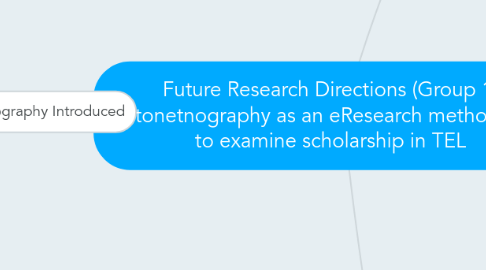
1. Autoethnography Introduced
1.1. Autonetnography introduced Kozinets & Kezidor (2009)
1.1.1. Literature Review
1.1.1.1. Ethnographies of the Internet
1.1.1.1.1. Move from traditional ethnography to network-based ethnography using the internet as the 'field' (Boellstorff et al. 2012; Horst & Miller, 2012; Beaulieu, 2004; Burrell, 2009; Wittel, 2000).
1.1.1.2. Autoethnography
1.1.1.2.1. Gaining popularity over recent years
1.1.1.3. Autonetnography
1.1.1.3.1. Kozinets & Kedzior (2009)
1.1.1.3.2. Mkono, Runanen & Markewll (2015)
1.2. Autonetnography as methodology through assimilating netnogrgraphy & autoethnography
1.2.1. Uses a researcher's personal experience to describe and critique the cultural practices and experiences of participating in TEL
1.2.2. Acknowledges and values TEL researchers relationships with others communicating online
1.2.3. Uses self-reflection (reflexivity) to name and interrogate intersections between the self and the online community, the particular and the general, the personal and the political (Adams, Holman-Jones and Ellis, 2015)
1.2.4. Shows TEL researchers in the process of understanding reflexively how they are learning
1.2.5. Balances intellectual and methodological trustworthiness, emotion and creativity
1.2.6. Offering TEL researchers a method for articulating their personal connections to - and their investment in - identities, experiences, online relationships and online culture(s)
1.2.7. TEL researchers can examine complex, insider accounts of sense-making and show how/why particular experiences are challenging, important and/or transformative
1.2.8. Making contributions to knowledge: "contributing to knowledge means extending existing knowledge and research whilst recognising that knowledge is both situated and contested. Contributing to knowledge also means valuing the particular, nuanced, complex, and insider insights that [autonetnography] offers researchers, participants, and readers" (Adams, Holman Jones & Ellis, 2015, p103)
1.2.9. “the mating of the reflexive, autobiographical mode of auto-ethnography and the online participant observation approach of netnography spawns auto-netnography” (Kozinets and Kedzior, p17).
2. But why?
2.1. Because it is suitable for the intersection between academic work and online activity
3. Future directions for autonetnography
3.1. Challenging or substantiating autonetnography as an emerging methodology in TEL
3.2. Developing an insider view of learning and/or teaching online
3.2.1. Exploring online teacher identity
3.2.2. Exploring online learner identity
3.2.3. Exploring the role of the vicarious learner
3.3. Asking the question "What does autonetnography offer TEL/NL?"
3.3.1. "There are still some very hazy connections between ways of knowing, forms of knowledge, material and digital tools and spaces, social relations and the activities through which people actually come to understand and improve the world" (Caralho & Goodyear, 2014, p275).
3.4. "Talking back" to the theory - engaging with the theory of autonetnography to explore its potential
3.5. What next?
3.5.1. Why
3.5.1.1. To examine trustworthiness of autonetnography in the context of TEL research
3.5.1.2. Will autonetnography help me get a job?
3.5.1.2.1. Well, autonetnography builds on autoethnography and that's an extension of qualitative research that you've already swallowed whole
3.5.1.2.2. Why do you mistrust the 'self' as a research vehicle?
3.5.1.3. To conceptualise the human elements associated with ontological and epistemological assumptions that are concerned with TEL research
3.5.1.3.1. Response to Q5...
3.5.1.4. Noggin The Nog was the first netnographer in 1959
3.5.1.4.1. Response to Noggin the Nog
3.5.2. How
3.5.2.1. Doesnt this just further fragment a fragmented field? (TEL) (argument from Legitimation Code Theory)
3.5.2.1.1. Response to q3 - Autoethnography is interested in the subjective
